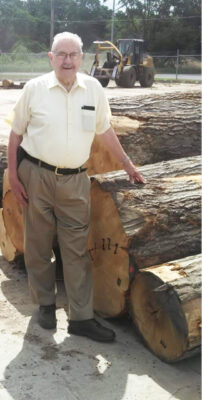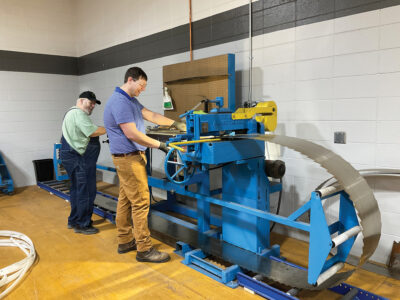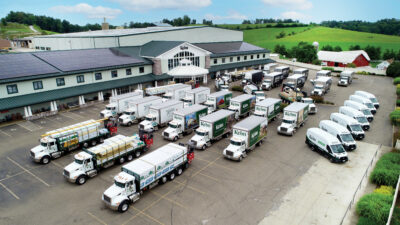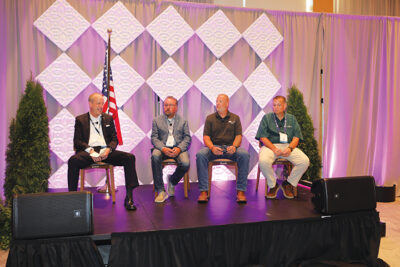
Across the Northeast, reviews on the market vary and many are concerned about what the future for conducting business overseas will look like.
In Vermont, a lumber spokesman said that the market has been a “little slow” but “maybe a tiny bit better than six months ago.”
They offer Eastern White Pine, which “kind of slows down in the wintertime,” in 4/4 – 12/4.
They sell to wholesalers and manufacturers and export “a little bit.” As for what his customers have been reporting, he mentioned, “I think everybody is finding it kind of the same as we are, a little bit slow. On top of that, the strength of the dollar has made it difficult to export.”
Regarding the proposed tariffs, he added “from a lumber manufacturers side, they would be beneficial. On a consumer level, I think it will be the opposite.” He also said that labor is “always a bit of a struggle” and that he expects demand will pick up in this new year and be better than 2024.
In New Hampshire, a lumber representative observed that the market is “about medium.”
Compared to six months ago, he explained that certain areas throughout the state are faring differently, “the wealthier areas in the state, such as Bedford and Manchester, are good around the lakes region. They are still building and the people in the middle class that were spending a lot during Covid-19 times, are not spending as much now. At least, that’s what it sounds like talking to my customers.” He said that overall, it was slower six months ago but is busier now.
They sell Eastern White Pine, Douglas Fir, Western Red Cedar and a little bit of Northern and Atlantic White Cedar, Alaskan Yellow Cedar, Sitka Spruce and Eastern Hemlock. Eastern White Pine is selling the best. He said they “do from millrun or Standard grade all the way up to Select grades and some of them are coming to clear vertical grain.”
Their customers are mostly contractors.
He said that “gas prices are still fairly high and I think the overall inflated cost of everything definitely wears on some of the people but mostly, the middle or lower class. Everything is so expensive that there’s no extra money for much right now. People have to buy wood to make money. They’re still buying but the volume seems to be down.”
A lumber spokesperson in Maine, when asked about current market conditions in his regions, provided a lot of details. “The demand is down in markets that we see. I think there are a lot of underlying things holding it down. Everybody is hoping that interest rates will come down and it’ll help spur some spending. Inventory levels at the retail level are low. Buying has been okay but overall, demand for 2024 was down for us. It’s pushed us to sell into different markets that we typically don’t sell to. Retailing in the Northeast is probably one of the stronger points across the country, especially in Maine but retail has stayed fairly busy in the Northeast versus other markets that we’re in. There’s been a fair amount of production taken off the market in Eastern White Pine, as for other species, too. I think there’s been enough off of supply and demand, that we’re a little bit better prepared at this time but again, demand is lower so when demand does go, it’s going to put some pressure on the supply side, which will obviously help firm prices and sell lumber. We’re hoping that is all coming at some point in time in 2025. I think some things need to fall in line for that to happen. 2024 was interesting and I think 2025 is going to be interesting, too. We’re getting by. In the sawmill business for most species right now, it’s kind of a grind. I think we’re just trying to find the right production rates across the country depending on species for what the demand is and obviously, we’re all hoping that demand gets better.”
As for comparing the current market to six months ago, he said that it is “maybe a little bit better because of supply size constraints.”
Eastern White Pine in 4/4 boards, pattern stock, all NELMA and proprietary grades are what they offer. According to him, “Ponderosa Pine is probably the one that has had value issues but again, everybody has had loss of value and the lack of demand. From a percentage standpoint, everybody is probably taking about the same percentage hit on pricing but it just depends. Eastern White Pine is a specialty, not necessarily a commodity so we play in different markets than some of the other big board guys.”
Their customer base consists of wholesale distribution partners, manufacturers, wholesale brokers, buying groups and they export some of their products in addition to having, as he said, “direct to retail programs.” He commented that “most retail people I talk to are off a little bit from last year but they feel that business has been decent enough for this year to have been a decent year for them and I would lump retail and wholesale distribution into that.”
As for his stance on proposed tariffs and the effect they may have on businesses in the import/ export areas, he said, “I don’t know how I think it’s going to affect what comes in here or what goes out of here, guarded that there might be some change coming, but guarded that we’re still going to be able to export products. We don’t import anything but I think it’s going to affect imports for sure. It would be interesting if imports are cut off or sized with a pretty hefty duty then people who buy those materials stateside will obviously have to pay more money for them and may have trouble getting them. It could cause some kind of a supply issue.”
For them, he said labor is “obviously a challenge. We spend a fair amount of time working on that. Just post-covid costs of labor, costs of insurance- everything has gone up. The post-covid cost is the different rate today for sawmills. It’s squeezing the mills for sure.”








